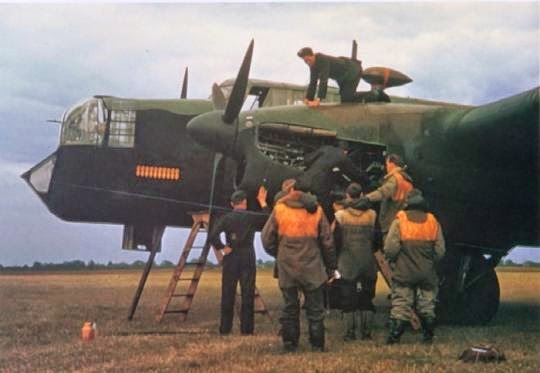The Whitley, designed in response to Air Ministry specification B.3/34, was an all metal twin engine monoplane bomber with retractable landing gear, and first flew on March 17, 1936. It entered service with RAF in March 1937, was one of the first heavy night bombers of the RAF and the first RAF aircraft with a stressed skin fuselage.
The high
incidence of the aircraft’s wing gave the Whitley a distinctive nose down
flying attitude. During the “phoney war” period, the RAF’s Whitley squadrons
bore the brunt of leaflet dropping raids over German cities, which resulted in
many losses. On March 19, 1940 Whitley’s dropped the first bombs on German
territory during World War II when they attacked the Hornum seaplane base on
the island of Sylt. The Whitley, together with the Wellington and Hampden
lightweights by the standards of later Bomber Command “heavies” formed the
backbone of the early British bomber offensive.
Heavy
losses during the winter of 1940-1941 and the introduction of four engine
aircraft meant that the Whitley’s front line activities were soon restricted to
Coastal command U-boat patrol duties over the approaches to their bases along
the French Atlantic coast. Coastal Command’s first success using air to surface
vessel (ASV) radar was by a Whitley VII of No.502 Squadron against U-Boat U 206
in November 1941.
The Whitley
I was delivered to the RAF off the drawing board while the Whitley II were
completed with two stage superchargers for the engines. Though similar to the
II, this version had a retractable ventral “dustbin” turret armed with two
0.303in machine guns this version could also carry larger bombs. The final 40
airframes of second production run were completed as Whitley IV with the famous
Rolls Royce Merlin engines and increased fuel capacity.
The Mark V
was similar to the Mark IV but replace the manually operated turret with a Nash
and Thompson powered tail turret with four 0.303in machine guns. As a result of
combat experience, the rear fuselage of this version was also extended by 15into
improve the rear gunner’s field of fire. Other changes included a revised fin
shape, the addition of a leading de-icing facility and greater fuel capacity.

The Whitley
VII was built specifically to serve with Coastal Command units on maritime
reconnaissance duties. The VII was equipped with ASV Mk II radar and can be
most readily identified from other versions by four dorsal radar masts atop the
rear fuselage, and numerous aerials carried. This model also differed by having
a sixth crew member and extra fuel tank age in the bomb bay and fuselage. Compared to early versions with a range of
1250 miles this version could reach distances of 2300 miles.
Earlier
Bomber Command versions were phased out of front line service from 1942, after
which they were used as trainers and glider tugs, the aircraft was heavily used
for training airborne troops for D-Day. During 1942-1943, 15 Whitley Mk V were
transferred to BOAC and given civil registrations to carry out Gibraltar to Malta supply
flights. Some Whitley served in the Fleet Air Arm until 1946 as flying
classrooms to instruct on Merlin engine handling and fuel transfer.






No hay comentarios:
Publicar un comentario